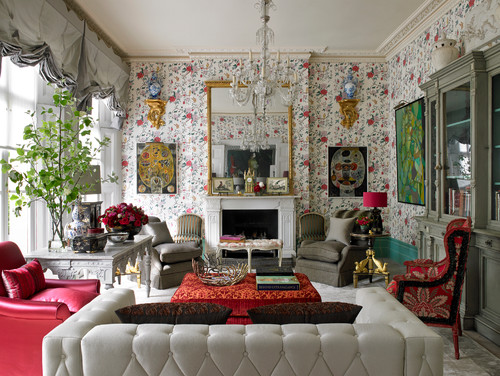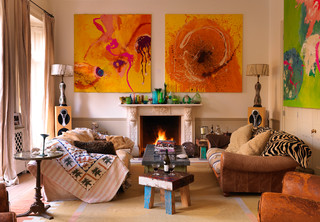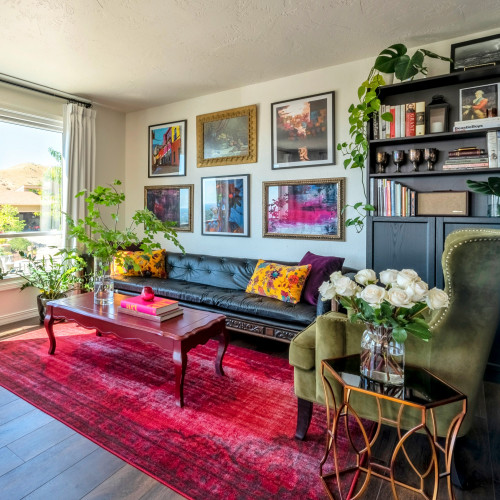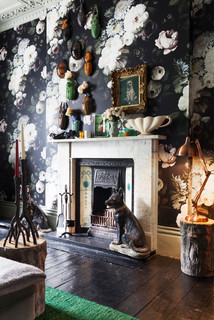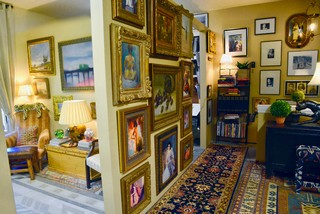Maximalism, with its lavish layers and intricate details, is rising from the quiet hum of the simpler past. Its roots are as old as art itself, twisting through eras that celebrated the ornate and the extravagant.
What is Maximalism?
Maximalism is a resplendent and unapologetically lush approach to design and art that wholeheartedly embraces complexity and abundance. Distinguished by daring prints, intricate patterns, and a diverse array of textures, maximalist designs are a veritable feast for the senses. This aesthetic outright rebels against the spartan ethos of minimalist design, instead of proclaiming a philosophy that is encapsulated by the mantra 'More is More.' Maximalism seeks to make a loud statement through vibrant colours and dynamic compositions—where interiors become a stage for theatrically bold displays, crafting spaces that feel both luxurious and engagingly layered.
In the world of maximalist design, elements are layered in such a way that they create an eclectic but coherent narrative, each piece adding to the richness of the overall tableau. Boho maximalism , emerging in the late 20th century , takes on a free-spirited approach that marries various influences, creating a sort of deliberate yet harmonious chaos.
These spaces often play host to an array of items gathered from travels, heirlooms, and eclectic finds—each with its unique story, contributing to an overall aesthetic that feels both worldly and personal. Using bold colours, eclectic patterns, and an array of textures, boho maximalism crafts a bold and unconventional space that is as expressive as it is inviting.
The Altered Art Print Trend
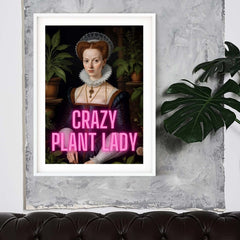
Altered art prints have surged in popularity as a means to introduce a sophisticated aesthetic at a fraction of the cost of original artwork. They merge the elegance of bygone eras with modern creative twists, blending classical charm with current trends and desires. In this mix, they embrace the ideals of maximalist design , blending centuries of fine art with the whimsical indulgences of everyday life.
Altered art posters offer a creative solution for consumers seeking to personalise their spaces with something truly unique. These prints resonate with those who desire to stand out, adorning homes and offices with an unparalleled beauty and personality. The boldness and layered complexity these prints bring to interiors are a clear shift in trend: a departure from minimalist restraint towards a world where vibrancy and exuberance reign supreme.

As we move forward, the rise of altered art reflects a collective embrace of maximalism in design, showcasing a hearty appetite for colour, life, and personalised storytelling in our living spaces.
There are many themes and expressions within altered art. Imagine vintage summer landscapes breathing new life with added contemporary motifs, or traditional baroque oil portraits unexpectedly companioned by a pair of sunglasses or an obviously modern accessory.
Evolution of Altered Art and Maximalism
Altered art has long been breaking the boundaries of traditional art, blending past and present, reverence and irreverence.

Today, altered art is experiencing a renaissance, becoming a dynamic intersection where rococo paintings are dusted off and reimagined with spirited modern elements—featuring poised women with the unexpected twist of a mask or the addition of modern elements.
What was once the epitome of classical beauty has been appropriated to reflect the playfulness and complexity of contemporary culture. Modern contexts have seen this trend explode across interior design scenes—eclectic kitchen posters and quirky wall art posters now fuse the ornate detail of baroque aesthetics with the refreshing simplicity and humour of today's sensibilities.

Women with bubblegum and balloons occupy space within A2 photo frames once reserved for stern, historical portraits. These images offer an homage to the elegance of the past while presenting a tongue-in-cheek nod to the present. The evolution of altered art is a fascinating journey of imagination that continues to challenge and entertain, merging two worlds into a tastefully maximalist space.
History of altered art and its roots in Dadaism and Surrealism
Altered art started with the avant-garde movements of the 20th century —Dadaism and Surrealism. Dadaist and Surrealist artists like Marcel Duchamp and Salvador Dali were instrumental in pioneering the use of everyday objects in artistic expression, pushing the boundaries of what was considered acceptable in art.
Their experimental method laid the groundwork for future generations of artists to remix and reconstruct historical designs into something entirely.
Negative Space as a Counterbalance to Maximalism
Maximalism celebrates the joy of excess, leaving behind the calm and calculated use of negative space typified by minimalism. Negative space is important even in the most eclectic maximalism. Particularly in Boho Maximalism , where every item tells a story, the strategic use of negative space prevents a space from veering into chaos.
By leaving areas less adorned, designers allow for visual breaks that allow each component space to breathe without overwhelming. This delicate balance sustains the core principle of Boho Maximalism —each element holds its ground in the whole.
The use of negative space , then becomes a powerful tool, ensuring that the maximalist design remains a vibrant and cohesive whole rather than a mass of competing elements.
Balancing Maximalism and Negative Space for Visual Harmony
To achieve visual harmony in a maximalist domain requires a deft touch, an understanding of how to distribute and layer elements to create a symphony rather than a solo.
Minimalist design focuses on a vast expanse of untouched space, whereas Boho Maximalism arrays textures, tones, and trinkets in an overlapping collage.. Balance is achieved by repetition and rhythm, allowing patterns to flow across the environment.
By combining multiple fonts, shapes, and palettes, maximalist design s create an eclectic mix that, remarkably, finds unity within its diversity. The intentional use of negative space provides an anchor, drawing the eye to appreciate the full, opulence of maximalism.
Bright Prints in the Maximalism Art Movement

Maximalist wall art does not shy away from the bold and the beautiful; it wholeheartedly embraces it. Bright colours take the spotlight, with hues like turquoise and magenta adding visual interest.
The true essence of maximalist contemporary art lies in its mastery of combining these electric shades with neutral tones, thus preventing it from veering towards the overwhelming.
Bold prints and patterns collide in a riot of colours, each vying for attention. Nothing sums up the spirit of maximalism quite like fashion icon Iris Apfel's motto: "More is More and Less is a Bore."
Techniques for Incorporating Bright Colours in Art Prints
In boho maximalism , incorporating vibrant colours into art prints is like conducting a symphony. Starting with a bold base colour, the palette expands to include contrasting shades that tell a vivid story.
To maintain visual appeal and avoid chaos, some restraint needs to be taken—pairing larger with smaller, busy with simple. Layering is a key technique that not only adds complexity but also comforts, allowing bold colours to make an inviting maximalist space.
Framed Neon Art: A Statement Piece

Framed neon art is the ultimate statement piece for spaces craving vibrancy and character. They bring an electrifying edge to wall art and their luminous shades fit perfectly within the maximalist realm.
The shock value of neon colours translates into neon posters that are impossible to overlook. By holding the power to turn a bland wall into the focal point of any room, whilst coexisting perfectly with more restrained 'normal' colour schemes - the use of Neon artwork becomes a multipurpose choice.
Neon typography for example, overlaid onto a traditional oil painting gives you chance to modernise your interior and honour the past.
Funky Prints: Reviving Vintage Art

Altered art prints are enjoying a renaissance in the 21st century , where modern art breathes new life into vintage oil paintings and art deco creations.
These funky prints inject humour and whimsy into the sophisticated swirls of Rococo and the solemn brushstrokes of Baroque—a delightful paradox where Ladies with iPhones coexist with classical backdrops. One such example is the playful reinterpretation of Rembrandt's "The Storm on the Sea of Galilee,".

This unique blending, suited for spaces ranging from eclectic office prints to humorous living room wall art, adds layers of intrigue to a maximalist space.
The choice within altered art spans scales from the intimate A5 to the commanding A1 size, allowing for a tailored approach to maximal decorating. Whether it's a quirky A2 wood frame print of girls enjoying drinks or an a3 wooden photo frame of a solitary figure with a modern twist, these pieces are exceptionally diverse.
Incorporating Maximalist Art into Home Décor
Maximalist décor is not simply a style; it's a bold statement that proclaims an affection for the full and the abundant. In an era where less has often been more, the resurgence of maximalism in home decor is marked by a celebration of excess and a craving for personal connection.
This approach to home design empowers individuals to surround themselves with wall art that resonates deeply with their own tastes and memories, creating a living tableau that is rich with storytelling and depth. When incorporating maximalism art examples into a home, the key lies in selecting pieces that evoke a strong personal connection.
Balancing Maximalist Pieces with Existing Décor
While maximalism encourages a more-is-more philosophy, achieving a cohesive look requires a deft balancing act. This balancing is particularly effective when using it in a space that may already have established decor.
It's about blending the new with the old to create a style that resonates. Consider mixing wooden frame styles and sizes such as A2 wood frames, with a5 solid oak frames and bright gold thrifted frames allowing for a range of art types to draw the eye across the space, crafting a visually interesting story.
Culturally significant elements, such as traditional fabrics, artefacts from travel or personal history, and hobby items (such as musical instruments, vinyl records, or individual collections) , can provide a personal narrative to a space, grounding the maximalist flair in a context that feels individual and intentional.
Tips for Integrating Maximalist Art Prints into Interior Design
When it comes to integrating maximalist art into interiors, remember that excess is a virtue.
Vibrant colours and enthusiastic patterns don't just fill a room; they add energy and define it. The incorporation of maximalist elements allows for a lively exhibition of textures and accessories that pull a room together into a cohesive celebration of life and style.
Using larger splashes of colour and pattern can help anchor a room, providing a focal point around which other elements can converse. The art of maximalism thrives on references that inspire—a nostalgia for places visited, stories heard, and the undomesticated beauty of nature—translating these themes onto wall coverings, fabrics, and even bedding to create a vivid environment.
Storytelling is key; aim to incorporate wall art that tells a tale, be it through the visual representation of landscapes, folklore, or intricate designs that echo natural habitats.
FAQs
What defines maximalism in art?
Maximalism in art can be summed up as an excess. It's dramatic and the designs dare to be bold. The ethos of maximalism lies in its celebration of excess, a mix of bright colors, layered fabrics, and patterns that pop. Maximalist art demands attention, showcasing a spectrum of experimental and vivid details. It's audacious, it’s spirited, it’s art unleashed
How can I incorporate maximalist art into my minimalist space?

Introducing maximalist art into a minimalist space may seem like mixing oil and water, but with deliberate choices, the two can create a personalised interior.
Select bold, vibrant art pieces that serve as the conversation starters of your room, anchoring themselves within an otherwise restrained space. Opt for big artworks that can be a dramatic centrepiece without cluttering the minimalist feel.
Mixing maximalist prints with your clean, minimalist lines fosters a dialogue between the two styles, allowing the art to stand out, bringing texture and depth to your space. The key is curation; ensure that every maximalist addition feels intentional, serving your vision for a balanced, interesting space.
Are neon prints suitable for all interior styles?

Neon prints are the exclamation points of maximalist interior design—bright, bold, and unmissable. While they can be a stunning addition to a variety of styles, including the ever-eclectic boho maximalism , they should be used carefully to avoid a feeling cluttered.
Cohesion is the watchword even in maximalist haven; motifs, colour themes, or singular concepts must unify the space, lending an organized chaos. Balance is critical—mix patterns with intention, pairing large with small, busy with simple, to ensure each design has room to breathe.


